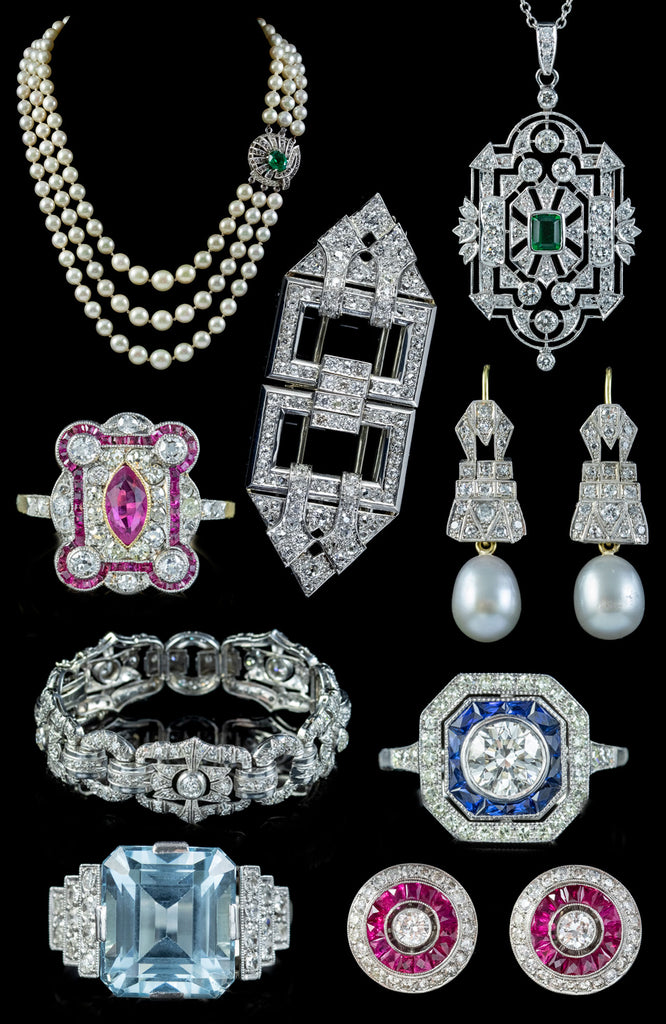Art Deco ·
Buyers Guide to Art Deco Jewellery
Learn more about the jewellery crafted during the Art Deco movement. A helpful guide for buyers and collectors from Laurelle Antique Jewellery.
The Art Deco movement, sometimes known as “Style Moderne” or simply “Deco” was a tremendously influential movement in art and architecture originating in the 1920s and becoming a major force in design in Europe and the United States until the late 1930s.

The Term Art Deco was not actually used to describe the movement until many years after it had ended. The many and varied styles which were involved had a common thread which was not necessarily visible to the artists who were producing the works at the time they were working.
The movement grew from the desire first expressed in Art Nouveau to create entirely new, modern styles which took advantage of developments in manufacturing, new materials and innovative new schools of thought. Art Deco was heavily influenced by the stark geometric forms pioneered in Cubism; a heavily abstract form of art that had similar goals of reinventing the way art was created.

Some of the core ideals of the Art Deco style were not dissimilar from those of the Edwardian era. Both periods focused on fine craftsmanship, fine materials and an overwhelming sense of luxury and exuberance. Where they differed was in Art Deco’s overwhelming faith in technological and social progress. The new and exciting styles which were being pioneered had, at their heart, an inherent optimism about the upward trajectory of art and human experience.
Although it originated in France, Art Deco is considered one of the first truly international artistic movements. Improvements in communications technology meant that ideas could be shared much more quickly and over greater distances than ever before. The modern ideals of the movement meant that these new technologies were quickly embraced, allowing Art Deco to spread across national borders with ease.

Art Deco Gold, Platinum and Silver
Between 1920 and 1930 yellow gold was out of fashion, and there was an increased demand for platinum jewellery. As platinum was in short supply jewellers looked to other materials to provide the same kind of aesthetic effect without making their pieces prohibitively expensive. The answer came in the form of white gold.
White gold was developed in the earth 19th century, and became commercially available in 1912. This new alloy, created from gold mixed with copper, zinc and nickel gave a similar silver colour to platinum, but at a fraction of the cost.
More affluent individuals still opted for platinum in their jewellery. This extremely rare material is heavy, hardwearing and tarnish resistant, however those without limitless funds had to make do with white gold, or cheaper and more readily available silver.
Art Deco Style
Stark geometric shapes were the hallmark of Art Deco pieces, and this can be seen in art as varied as painting, prints and even architecture.Art Deco jewellery was often built around large, angular central stones. Emerald cuts, with their long straight lines and relatively simple facets, formed popular centrepieces for rings in particular. Broad, tall faces and elaborate symmetrical patterns inspired by the march of progress in science and industry were also common.

Along with these new forms, Art Deco jewellers also embraced new materials, combining existing gemstones with man-made materials such as glass and plastics. The use of platinum and new, stronger gold alloys allowed the amount of metalwork in pieces to be reduced without impairing their durability. This, coupled with the overarcing principles of pride in technological advancement, led to more minimalist designs.
Where jewellers from previous eras had elaborated on the intricate engravings and complex metalwork which were the style of the day, jewellers from the Art Deco period invested their time in smaller, trimmed down forms which achieved a rather more severe, but no less worthy form of beauty.

Workmanship, Rarity and Value
Art Deco jewellery tends to be more readily available than other historic pieces. This is in part due to the fact that less time has passed, leaving less time for pieces to be lost or destroyed. It is also due to the fact that many of the manufacturing processes pioneered in the earlier Victorian Era had now been perfected, resulting in stronger pieces crafted from more durable materials.Although Art Deco pieces may be more numerous they are also a great deal more varied. New processes allowed jewellers to experiment with a variety of forms; in fact during the period many styles which are now considered part of the Art Deco movement existed entirely separately from one another, as jewellers made and remade the rules of fashion depending on their own interpretation.

It is the artistic movement itself that appeals so greatly to collectors, and means that particularly fine examples of the principles and common traits of Art Deco jewellery can fetch an extremely high price. Where the specific provenance of Georgian, Victorian and Edwardian pieces may be lost to history, it can be easier to attribute the origin of a particular piece. Pieces that can be accurately placed in the development of the movement are particularly prized, and can command the highest prices
At Laurelle Antique Jewellery we have spent years developing the necessary expertise to identify, acquire and present the finest Georgian jewellery in the United Kingdom. To view our full collection of Art Deco pieces click here. You can also find our collection on fine Art Deco Engagement rings here.
Click the links below to learn more about the Georgian, Edwardian and Victorian periods.
The Georgian Period
The Edwardian Period
The Victorian Period
Find Vintage Art Deco Jewellery With Laurelle Antique Jewellery
Contact us should you have any questions about our available vintage jewellery products or need help sourcing a particular item of art deco Jewellery for your collection.



